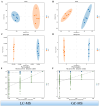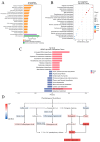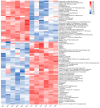Comparative Analysis of the Chemical Constituents of Chrysanthemum morifolium with Different Drying Processes Integrating LC/GC-MS-Based, Non-Targeted Metabolomics
- PMID: 39330488
- PMCID: PMC11434334
- DOI: 10.3390/metabo14090481
Comparative Analysis of the Chemical Constituents of Chrysanthemum morifolium with Different Drying Processes Integrating LC/GC-MS-Based, Non-Targeted Metabolomics
Abstract
Chrysanthemum morifolium is a perennial herbaceous plant in the Asteraceae family that is used as a medicine and food owing to its superior pharmacological properties. Irrespective of its application, C. morifolium must be dried before use. Shade drying (YG) and heat drying (HG) are the two drying methods used in most origins. Given the abundance of flavonoids, phenolic acids, and terpenoids, the primary medicinal active constituents of C. morifolium, it is important to determine whether the composition and content of these compounds are altered during the drying processes. To test this, the changes in the chemical composition of C. morifolium flowers after YG and HG using full-spectrum, non-targeted LC/GC-MS-based metabolomics and, subsequently, the three indicator components of C. morifolium-chlorogenic acid, 3,5-dicaffeoylquinic acid, and luteolin-7-O-glucoside-were accurately quantified by HPLC. The results of the non-targeted metabolomics analysis revealed that YG- and HG-processed C. morifolium differed significantly with respect to chemical contents, especially flavonoids, phenolic acids, and terpenoids. The levels of the indicator components and their precursors also differed significantly between the YG and HG treatments. The contents of most of the flavonoids and key phenolic acids, terpenoids, and carbohydrates were higher with YG than with HG pre-treatment. These results revealed the changes in the chemical composition of C. morifolium during the YG and HG processes, thus providing a reference for the further optimization of the production and processing of chrysanthemums.
Keywords: Chrysanthemum morifolium; heat drying (HG); high performance liquid chromatography; non-targeted metabolome; shade drying (YG).
Conflict of interest statement
Author Kai Liu was employed by the company Bozhou Xinghe Agricultural Development Co., Ltd. The remaining authors declare that the research was conducted in the absence of any commercial or financial relationships that could be construed as a potential conflict of interest.
Figures







Similar articles
-
[Effect of different sulfur fumigation dosages on activity of browning enzymes and chemical constituents of Chrysanthemum morifolium cv. Boju].Zhongguo Zhong Yao Za Zhi. 2019 Nov;44(22):4852-4856. doi: 10.19540/j.cnki.cjcmm.20190901.304. Zhongguo Zhong Yao Za Zhi. 2019. PMID: 31872592 Chinese.
-
Quantitative comparison of caffeoylquinic acids and flavonoids in Chrysanthemum morifolium flowers and their sulfur-fumigated products by three-channel liquid chromatography with electrochemical detection.Chem Pharm Bull (Tokyo). 2015;63(1):25-32. doi: 10.1248/cpb.c14-00515. Chem Pharm Bull (Tokyo). 2015. PMID: 25743191
-
Comparative Analysis of Phytochemical Composition of Gamma-Irradiated Mutant Cultivars of Chrysanthemum morifolium.Molecules. 2019 Aug 19;24(16):3003. doi: 10.3390/molecules24163003. Molecules. 2019. PMID: 31430944 Free PMC article.
-
Chrysanthemum morifolium as a traditional herb: A review of historical development, classification, phytochemistry, pharmacology and application.J Ethnopharmacol. 2024 Aug 10;330:118198. doi: 10.1016/j.jep.2024.118198. Epub 2024 Apr 14. J Ethnopharmacol. 2024. PMID: 38621465 Review.
-
[Advances in the study on chemical constituents of Chrysanthemum morifolium Ramat].Zhong Yao Cai. 2004 Mar;27(3):224-6. Zhong Yao Cai. 2004. PMID: 15346588 Review. Chinese. No abstract available.
References
-
- National Pharmacopoeia Committee . Pharmacopoeia of the People’s Republic of China. China Medical Science and Technology Press; Beijing, China: 2020. pp. 323–324.
-
- Hu C. Chrysanthemum Morifolium Ramat (Juhua, Florists Chrysanthemum) Springer; Vienna, Austria: 2015.
-
- Cheon M.S., Yoon T., Choi G., Moon B.C., Lee A.Y., Choo B.K., Kim H.K. Chrysanthemum indicum Linné extract inhibits the inflammatory response by suppressing NF-κB and MAPKs activation in lipopolysaccharide-induced RAW 264.7 macrophages. J. Ethnopharmacol. 2009;122:473–477. doi: 10.1016/j.jep.2009.01.034. - DOI - PubMed
LinkOut - more resources
Full Text Sources
Miscellaneous

